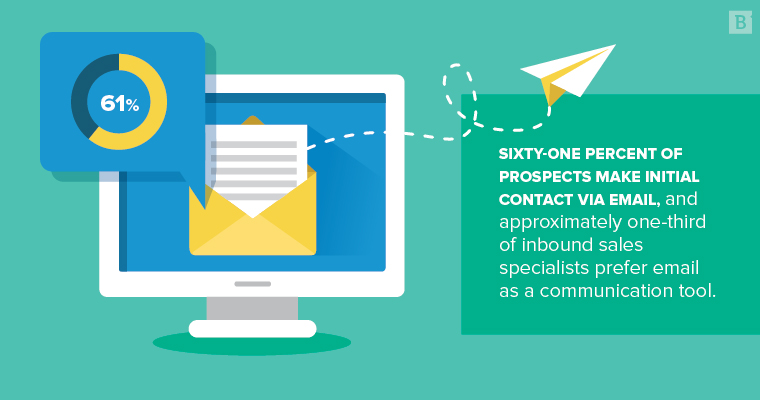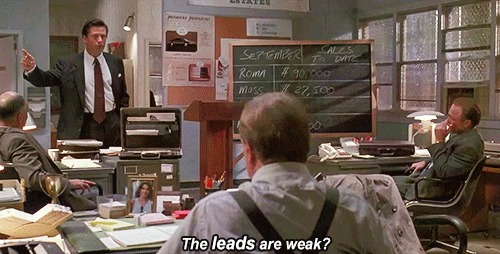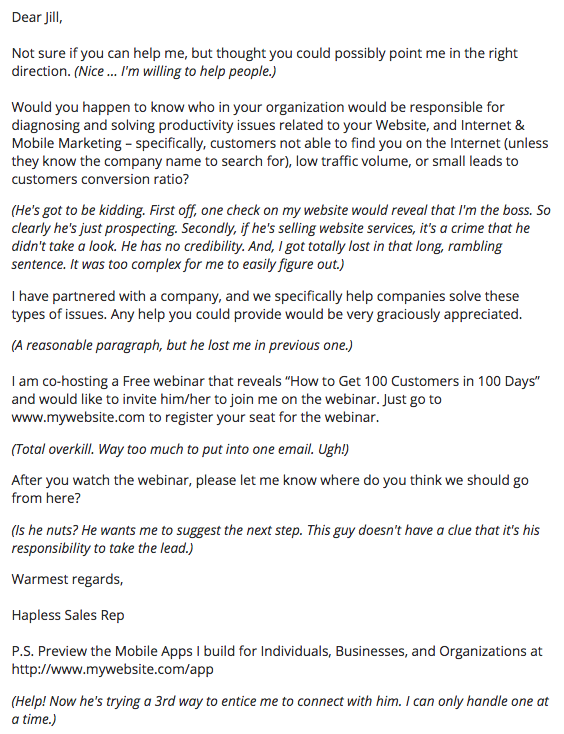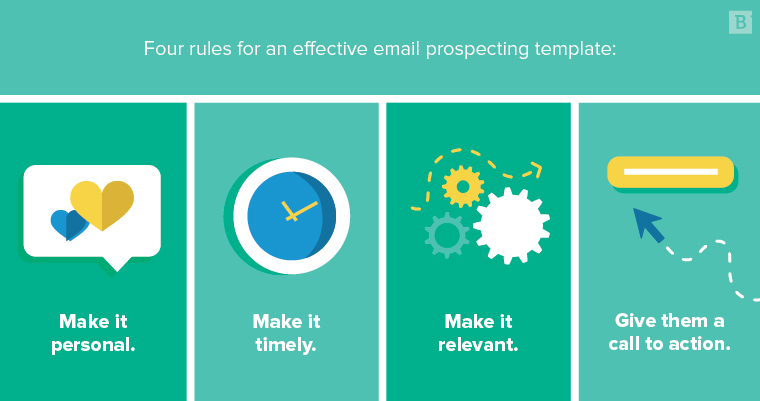Think modern-day sales is still all about cold-calling? Think again.
Sixty-one percent of prospects make initial contact via email, and approximately one-third of inbound sales specialists prefer email as a communication tool.
That’s not to say there’s no place whatsoever for cold-calling today, but if your prospecting strategy solely revolves around a sales team blazing through rolodexes, then you are well behind the times. Not to mention, you’re probably wasting time and resources that could be better spent on actually identifying qualified leads and nurturing them to quantifiable conversions.
How? With a heavier focus on inbound sales – and email prospecting is a core part of that strategy.

What is email prospecting?
Your website is ground zero for lead generation, filled with digital breadcrumbs leading back to potential sales prospects. Site visitors, contact forms and gated content all provide ample leads who have demonstrated varying levels of interest in your business.
The next step is to make contact, and that’s where email prospecting comes in. Experienced sales reps have shifted their focus away from making phone calls and over to using email to strike up conversations with potential leads. InsideSales.com Partner and Field Marketing Specialist Scott Mark hit the nail on the head when he noted that “clients are too busy to take the call in the first place.”
“Most clients or prospects don’t want to talk on the phone,” Marks said. “Email is non-threatening – they can reply when they want to, they don’t have to have a conversation on the spot. Email gives the customer more freedom.”
When done right, email prospecting is much more efficient than cold-calling, as your contacts have already shown some degree of interest – however implicit – in your brand. You don’t need to come crashing in with a whole elevator pitch because chances are they’ve already read up on your business, your products and services, messaging and maybe even a case study or two.
In theory, email prospecting enables you to start the sales process with a qualified lead who is receptive to your brand messaging already in play. That’s a strong position to be in, and a very compelling argument for email prospecting as a foundational element in any B2B sales and marketing strategy.
64 percent of sales teams that focus on inbound sales in this manner ultimately hit their quotas. In comparison, less than half of outbound sales teams manage the same feat.
In one of the more incredible success stories out there, IBM saw its sales increase 400 percent after transitioning to an inbound model.
Email prospecting challenges
Of course, email prospecting isn’t some kind of panacea that will cure all of your sales woes. Anyone with a business email address can tell you that there is a glut of content piling up in inboxes everywhere.
Chances are, there’s a prospecting email sitting in your inbox right now (or, more likely, your spam folder).
Like just about every other aspect of digital sales and marketing, you need to find a way to cut through the noise. Just getting leads to open your emails is a relatively tall order, to say nothing of them actually reading it, clicking on an included link or responding.
How can you avoid wasting time sending emails to prospects who don’t have all that much potential in the first place? By doing your homework.
Qualify leads for email
There are a variety of different ways to qualify your leads, ranging from pretty basic to fairly granular:
Target demographic: You would be surprised at the number of prospecting emails that go out to people who don’t even operate in the right industry or are located outside of a company’s operational footprint. Actually, check that, given the number of mismatched sales emails you’ve received, you probably wouldn’t be all that surprised by how often they completely miss the mark on their own demographics.
Business size: It seems obvious, but a lot of prospecting emails are sent to organizations that are either too large or too small. If you cater exclusively to the enterprise crowd, don’t waste time contacting an SMB audience.
Buyer persona: Are you trying to get in touch with a decision-maker or influencer? Know your audience and their pain points and you can craft more impactful prospecting emails.
Projected value: Obviously, you want to prioritize those leads who present more lucrative opportunities, whether because they work for a company with deep coffers, would be more receptive to upsell proposals or project more long-term value as a customer.
The whole idea is to be more efficient and surgical, and that means doing your research beforehand so you don’t waste time chasing down poor or unprofitable prospects.
Addressing legal and ethical concerns
There are no shortcuts when it comes to strong email prospecting – that doesn’t stop some businesses from trying to come up with their own, though. The most common tactic is to buy email lists filled with the contact info of thousands of potential leads. This approach is potentially problematic, though.
The CAN-SPAM Act lists a number of strict guidelines that any commercial email must adhere to, including being absolutely transparent in your intentions and providing recipients with an opt-out mechanism. It goes a step further and outlaws the sale of any email address that has opted out of these exchanges. There’s always the possibility that a purchased email list contains one of these off-limits addresses, putting your business in a legal quagmire.

So, what else should you steer clear from when email prospecting? From a legal perspective, keep these tips in mind:
Include the aforementioned opt-out clause. Not only will it keep you compliant, but you can easily weed out unreceptive prospects early on without wasting a lot of time and energy repeatedly following up.
Don’t mislead the recipient with any false or overstated promises in the subject line. CAN-SPAM banned these kinds of tactics, and potential prospects will only be disappointed by the contents of the email itself.
Be cognizant of country-specific regulations if you’re extending your marketing reach outside of the U.S. Other nations may have stricter guidelines in place that you’ll need to account for.
Email prospecting best practices
We touched on it before, but the most successful email prospecting strategies prioritize prospects into clearly defined buckets, so brands get the most bang for their buck. Each prospect tier should be treated differently, not just in terms of the material sent their way, but also how often you contact them. You don’t want to overwhelm someone who isn’t primed and ready to have a more comprehensive conversation.
HubSpot broke down a few different prospect tiers to keep in mind, with the highest priority being those individuals who are basically no-brainer prospects:
- They fit your customer profiles like a glove.
- They have a direct line of communication to and influence on a key decision-maker.
- There is a clear business problem that your organization can help solve.
- They’ve already established a high level of engagement with your brand – downloaded gated assets, visited multiple pages on your website, tweeted at your Twitter handle, etc.
These are the prospects you can reach out to on a more regular basis. The further removed prospects are from this golden standard, the less active your strategy should be.
You may also want to consider doing a little independent research on your top-tier prospects to see if you can finetune your emails to maximize engagement and your odds of response. Email address lookup tools can help with finding direct contact info.
When working as an Account Executive at Voxa, Kyle Van Pelt took this approach to the next level, reading as many as 30 blogs either written by the target or appearing on their company’s site to tweak prospect emails to focus on their specific interests and concerns. He credits this method with his eye-popping 90-percent response rate. Whether or not that figure is exact, it seems pretty clear getting more granular can pay off big time.
What not to do
There’s no shortage of prospecting email templates out there to pore over – like here, here and here – but which approach is the best?
Let’s start with what not to do. Sales expert Jill Konrath gave a pretty savage breakdown on what a bad prospecting email looks like, using some poor – and thankfully anonymous – sap as an example.

One of the cardinal sins this email commits is lacking any kind of specificity and personalization. If you can’t show a prospect you view them as more than just a random email address, you’ve probably already lost the battle.
Another misstep Konrath pointed out was overloading the reader with too many follow-up items. It puts too much responsibility on the recipient when you should be guiding the conversation.
You also lose out on one of the key advantages email prospecting has – the format is undaunting. There’s no pressure to hop on a phone call and talk things over with a sales rep. The target can respond at their leisure. You inundate them with to-do list items like this guy did, and suddenly this all starts to feel like homework.

What to do
As far as what you should include in an email template, there are four important rules to follow:
Make it timely.
Make it relevant.
Make it personal.
Give them a call to action.
The best prospecting emails seem to land at just the right time with just the right message. Again, this goes back to doing your prep on high-priority prospects and making sure you tailor every aspect of your communication accordingly. The more detailed and personalized it can be, the more likely it is to resonate with your audience.
And if you want to get through to your audience and grab the attention of lucrative prospects, you need to demonstrate that brand value right off the bat.
If you’re looking for a quick fix, there aren’t any when it comes to email prospecting. But hard work and due diligence will get you where you want to go.






